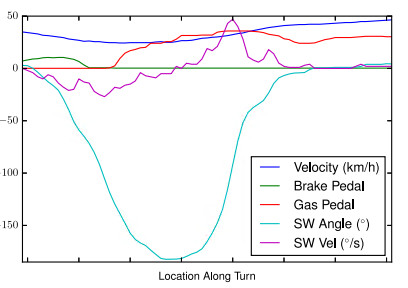| I Know Who You Are By The Way You Take A Corner |
| Written by Harry Fairhead | |||
| Tuesday, 17 October 2017 | |||
|
There are many things that reveal identity, but the way you drive around a corner doesn't seem that likely a candidate. However, it seems it can give you away. A sensor data from a single turn, preferably in a rural setting, seems to be enough. Two new pieces of research on identifying drivers from how they take a corner have just been published. The first uses only data from sensors mounted in the car and the second uses only data from a smartphone that just happens to be in the car. Researchers from Stanford, Volkswagen and Audi have asked a question that might not have occurred to most. Given that modern cars have lots of sensors collecting lots of data, is it possible to deduce who is driving from a short set of sensor readings - preferably as soon as the car turns out of the driveway. The reason given for wanting to do this is so that the car can adjust things like the mirror position and so on, but building driver profiles in general seems like a potential use. I'm sure you can invent your own uses for the data. Turns are a good candidate for the task as the driver has to slow down, rotate the wheel and determine the car's trajectory through the turn before accelerating out. This complex piece of behaviour has enough degrees of freedom to encode the driver's identity. Form a dataset of turns, the team attempted to train a classification algorithm with the top 12 turns. Below you can see the top four turns:
The soft of data used included things like velocity, brake and gas pedal depression and so on:
In all twelve signals plus GPS were used to build a random forest classifier. The results were surprisingly good. When the choice was between two drivers, the accuracy was between 55% and 93% and for five drivers the accuracy was between 33% and 70%, where you would only expect 20% by guessing. These results are based on data from a single turn. What is also interesting is that for rural turns the accuracy was highest - 80% to 95% for two drivers. The researchers speculate that in these locations are going to be fewer external factors like pedestrians etc to cause the driver to deviate from a natural style. A second group of researchers, this time from the University of Michigan, asks a similar question but this time adding gyroscope and accelerometer. Their program Dri-Fi (Driver Fingerprint) seems to perform even better than using just car data and GPS. Again with data obtained from a single turn the classification accuracy was 74%, 84% and 91% for 12, 8 and 5 possible drivers. If you allow the system to have more data, i.e. more turns, the accuracies go up to 95% to 96%. Notice that in this case the sensors are in a standard mobile phone - no need to connect to the car's sensor system. So it seems we can determine who is driving from a single turn.
More InformationDriver Identification Using Automobile Sensor Data from a Single Turn Mobile IMUs Reveal Driver's Identity From Vehicle Turns Related ArticlesRobot cars - provably uncrashable?
To be informed about new articles on I Programmer, sign up for our weekly newsletter, subscribe to the RSS feed and follow us on Twitter, Facebook or Linkedin.
Comments
or email your comment to: comments@i-programmer.info |
|||
| Last Updated ( Tuesday, 17 October 2017 ) |



